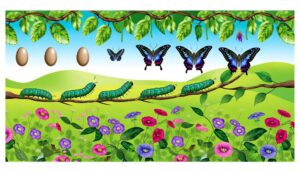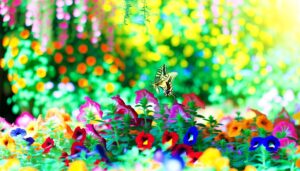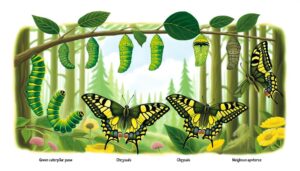Eastern Swallowtail Butterflies Come Out in Utah: Overview!
Eastern Swallowtail butterflies, recognized by their yellow and black coloration and blue and orange spots on males, emerge in Utah during spring and summer.
They inhabit meadows, woodlands, and urban gardens. Their migration is driven by seasonal changes and availability of nectar sources such as milkweed, thistles, and clover.
The life cycle includes egg, larva, pupa, and adult stages, with adults living 6-14 days. Conservation efforts focus on preserving native flora to support their populations.
Observing these butterflies in their natural habitats provides insight into their ecological roles and behavior patterns. For more detailed information, further exploration will be insightful.

Key Takeaways
Identification Features
Eastern Swallowtail butterflies in Utah can be identified by their distinct yellow and black coloration, with males typically exhibiting more pronounced blue and orange spots on their hindwings. Adult wingspans range from 8.9 to 14 cm.
The forewings feature four black tiger stripes on a yellow background, while the hindwings possess a characteristic ‘tail.’
Females may display more extensive blue scaling on their hindwings compared to males. The ventral side of the wings shows a pale yellow hue with black banding.
Pupae exhibit dimorphism, appearing either green or brown depending on seasonal conditions.
Accurate identification can be essential for ecological studies and conservation efforts, empowering enthusiasts to contribute meaningfully to biodiversity monitoring in their local environments.
Habitat and Range
Though native to the eastern United States, the Eastern Swallowtail butterfly has expanded its range into Utah, thriving in diverse habitats such as meadows, woodlands, and urban gardens.
These butterflies adapt well to various ecological niches, reflecting their resilience and ecological plasticity. In Utah, they’re frequently observed in areas with abundant floral resources and host plants for their larvae.
Key factors contributing to their successful habitation include:
- Availability of nectar sources: Essential for adult nutrition.
- Presence of host plants: Vital for larval development.
- Climate adaptability: Tolerates a range of temperatures.
- Minimal pesticide exposure: Supports population growth.
Their ability to colonize new areas underscores their ecological versatility and highlights the interconnectedness of habitats across regions. This adaptability illustrates how species can transcend their native boundaries.
Migration Patterns
Researchers have observed that the migration patterns of Eastern Swallowtail butterflies in Utah are influenced by seasonal changes and the availability of floral resources.
Data indicates that these butterflies migrate northward during the spring and summer months, when temperatures rise and nectar-rich flowers bloom profusely.
Conversely, they move southward as temperatures drop in the fall, aligning with the decline in floral abundance. Quantitative analysis of butterfly counts and floral density supports this correlation.
The butterflies’ migratory behavior guarantees access to ideal feeding and breeding grounds, thereby enhancing their survival and reproductive success.
This precise adaptation underscores the intricate relationship between Eastern Swallowtails and their ecosystem, highlighting the importance of preserving floral habitats to sustain their populations.
Life Cycle Stages
The life cycle of Eastern Swallowtail butterflies encompasses four distinct stages: egg, larva (caterpillar), pupa (chrysalis), and adult.
The process begins when females lay eggs on host plants. Hatching occurs within 4-10 days, leading to the larval stage, where caterpillars undergo five instars, growing rapidly.
After approximately 3-4 weeks, they progress into the pupal stage, forming a chrysalis. This stage can last from several weeks to months, depending on environmental factors. Finally, adults emerge, ready to reproduce and perpetuate the cycle.
- Egg stage duration: 4-10 days
- Larval stage duration: Approximately 3-4 weeks
- Pupal stage duration: Several weeks to months
- Adult lifespan: 6-14 days
This data highlights the intricate, timed phases essential for their survival.
Feeding Habits
Eastern Swallowtail butterflies primarily consume nectar from a variety of flowering plants, with a strong preference for species such as milkweed and clover.
Their feeding habits exhibit clear seasonal patterns, adapting to the availability of local flora throughout the year.
Data indicate that these butterflies optimize their foraging efficiency by targeting blooms with high nectar yields during peak flowering periods.
Preferred Nectar Sources
Feeding mainly on nectar from flowering plants, Eastern Swallowtail butterflies exhibit a strong preference for milkweed, thistles, and clover.
These butterflies, known scientifically as Papilio glaucus, demonstrate selective feeding habits influenced by the availability and nutritional content of these plants.
Detailed studies reveal that their foraging behavior maximizes energy intake while minimizing time and effort.
Key nectar sources include:
- Milkweed (Asclepias spp.)
- Thistles (Cirsium spp.)
- Clover (Trifolium spp.)
- Lilacs (Syringa vulgaris)
This preference isn’t random but driven by the high nectar yield and accessibility of these flowers. Such selective feeding guarantees ideal energy for reproduction and migration, essential for their survival in diverse habitats like those found in Utah.
Flowering Plant Preferences
Researchers have identified that Papilio glaucus shows a clear preference for flowering plant species with high nectar production and easy accessibility.
Commonly favored genera include Asclepias, Liatris, and Echinacea, known for their abundant nectar and open floral structures. Studies indicate that these butterflies maximize energy intake by selecting blooms with a high nectar-to-effort ratio.
Data shows they frequently visit flowers with shallow corollas, facilitating efficient feeding. This preference enhances their reproductive success and survival rates.
Field observations in Utah confirm these trends, with Papilio glaucus frequently observed on milkweed and coneflower species.
Such preferences underscore the importance of preserving native flowering plants to support local butterfly populations and maintain ecological balance.
Seasonal Feeding Patterns
Observations indicate that Papilio glaucus adjusts its feeding habits seasonally, aligning nectar consumption with the availability of specific flowering plants throughout the year. In spring, they mainly feed on lilacs (Syringa vulgaris) and wild cherry blossoms (Prunus serotina).
Summer months see a shift towards milkweed (Asclepias spp.) and Joe-Pye weed (Eutrochium purpureum). By autumn, goldenrods (Solidago spp.) and asters (Aster spp.) become primary nectar sources.
This seasonal foraging strategy promotes efficient energy intake and supports reproductive cycles.
- Spring: Lilacs, wild cherry blossoms
- Summer: Milkweed, Joe-Pye weed
- Autumn: Goldenrods, asters
- Adaptation: Aligns with flowering plant availability
This precise adaptation to floral phenology highlights their ecological flexibility and resilience.
Role in Ecosystem
Eastern Swallowtail butterflies play a crucial role in pollination, thereby enhancing plant diversity in Utah’s ecosystems. Their presence influences predator and prey dynamics, serving as both food sources for birds and predators of aphids.
Seasonal migration patterns aid in the redistribution of genetic material among plant populations, promoting ecological resilience.
Pollination and Plant Diversity
Swallowtail butterflies play an important role in pollination, greatly impacting plant diversity and ecosystem health in Utah. Their interaction with various flowering plants promotes genetic diversity and enhances plant reproduction rates.
By transferring pollen, they facilitate the growth of seeds and fruits, which are vital for many plant species’ survival and propagation.
Swallowtails exhibit high efficiency in transporting pollen across long distances. Their activity supports a broad range of plant species, enhancing biodiversity.
Increased plant diversity leads to more resilient ecosystems, capable of withstanding environmental changes. As pollinators, swallowtails contribute to the food web by supporting plants that serve as food sources for various organisms.
These butterflies are essential for maintaining ecological balance and diversity.
Predator and Prey Dynamics
In addition to their role in pollination, swallowtail butterflies serve as both prey and predators, influencing the population dynamics and behavior of various species within Utah’s ecosystems.
As larvae, these butterflies feed on host plants, controlling vegetation growth and providing a food source for birds and small mammals.
Predation on adult swallowtails by birds, spiders, and other insects impacts their survival rates and reproductive success.
Additionally, swallowtail larvae exhibit Batesian mimicry, resembling toxic species to deter predators. This interaction shapes predator behavior, reducing predation pressure on true toxic species.
Habitat and Migration Patterns
Many species of swallowtail butterflies, including the Eastern Swallowtail, exhibit distinct habitat preferences and migration patterns that greatly influence their role in Utah’s ecosystems. These butterflies thrive in diverse habitats, such as woodlands, meadows, and gardens.
Seasonal migrations are vital for their survival, as they seek ideal conditions for feeding and reproduction. Eastern Swallowtails contribute to pollination, enhancing biodiversity and ecosystem resilience.
- Preferred Habitats: Woodlands, meadows, gardens
- Migration Timing: Seasonal, primarily spring and summer
- Pollination Role: Essential for plant reproduction
- Feeding Preferences: Nectar from various flowering plants
Their migration and habitat selection are essential to maintaining ecological balance, underscoring the importance of preserving these environments for future generations seeking natural freedom.
Conservation Status
The conservation status of Eastern Swallowtail butterflies in Utah indicates a stable population, supported by recent field surveys and habitat assessments. These studies highlight the availability of suitable host plants and nectar sources that sustain their life cycle. Additionally, conservation efforts, including community education and habitat preservation, contribute to maintaining their numbers. Some enthusiasts have also explored swallowtail farms butterfly release reviews to understand the impact of captive breeding on local populations.
Researchers have documented consistent numbers across multiple habitats, suggesting that current ecological conditions are favorable.
Key factors include the availability of host plants, such as wild cherry and ash, and the absence of significant threats from pesticides or habitat destruction.
Population density estimates hover around 15-20 individuals per hectare in ideal areas, with no alarming declines observed over the past decade.
Conservation efforts focus on preserving native flora and minimizing urban encroachment. Continued monitoring will guarantee these butterflies thrive without imposing restrictive measures, allowing enthusiasts to enjoy these vibrant insects in their natural environments freely.
Viewing Tips
Successfully spotting Eastern Swallowtail butterflies in Utah requires visiting areas with abundant wild cherry and ash trees, particularly during their peak activity periods in late spring and early summer.
Observers should focus on regions where these host plants thrive, as they provide essential larval food sources.
Best viewing times are early morning, when butterflies are most active.
- Bring binoculars: Enhances distant observations without disturbing the butterflies.
- Wear neutral colors: Reduces the likelihood of startling the butterflies.
- Use field guides: Helps in accurately identifying Eastern Swallowtails among similar species.
- Stay on trails: Minimizes habitat disruption and increases the chances of sightings.
Utilizing these tips can greatly enhance the likelihood of encountering these mesmerizing lepidopterans in their natural habitats.
Conclusion
In summary, Eastern Swallowtail butterflies, with their striking yellow and black wings, enrich Utah’s biodiversity. They thrive in various habitats, from meadows to gardens, and play vital roles in pollination.
Despite their beauty, they’re not just another pretty face; they serve as bioindicators of a healthy ecosystem. With ongoing conservation efforts, these butterflies will continue to flutter through Utah’s landscapes, a vivid brushstroke in nature’s masterpiece.
Observing them requires patience and respect for their delicate existence.






